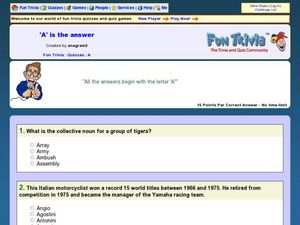Curated OER
"A" is the Answer
Challenge your High school learners by asking them to investigate these trivia questions. The must use the internet to discover the answers. All sorts of questions are asked: everything from questions about famous people, inventions,...
Curated OER
The Kitchen Sink-N
Challenge your learners with this trivia worksheet. They can use research techniques to find the answers to questions about famous poems, world history, and vocabulary terms.
Curated OER
Next up: A neat "N" Quiz
Challenge your high schoolers' research skills by having them use the Internet to find the answers to the trivia questions in this on-line worksheet. Answers all begin with the letter "N." All sorts of questions are posed: everything...
Bright Hub Education
Math Lesson for Visually Impaired Early Learners: A 3 Way Counting Activity
A unique lesson that's designed for visually impaired early learners, but can be adapted for anyone, is here for you. Pupils use brightly colored foam letters, beads, checkers, and an abacus, in order to gain practice in identifying the...
Curated OER
Now You're Speaking My Language; Deciphering the Symbols of Early Civilizations
Young scholars explore early attempts at written language. In this early civilizations lesson plan, students investigate first attempts at written communication. Among the civilizations covered are Mayan, Greek, and Egyptian.
Curated OER
Cows That Type Friendly Letters
Students engage in a lesson that introduces the parts of a letter. The lesson is taught using a powerpoint presentation with the purpose of integrating technology into instruction. Students create a letter and thinking map to challenge...
Curated OER
Family Fun (Part 2)
In this English worksheet, students participate in a variety of English learning games including Letter slap, Spelling anti-cocktail and I-spy. Students enjoy twenty-six different activities.
Curated OER
Flag Day Alphabet Activity
For this Flag Day worksheet, students read 9 words pertaining to the history of the American flag. Students put the words in alphabetical order. Some words begin with the same letter.
Willow Tree
Data Sampling
Some say that you can make statistics say whatever you want. It is important for learners to recognize these biases. Pupils learn about sample bias and the different types of samples.
Classroom Adventures Program
Creating Characters
Examine character in depth. Over the course of these six lessons, learners explore their own character traits, determine the traits of characters in the books they read, practice comparing and contrasting, and collaborate in small groups...
Curated OER
A? I Can't Hear You
Students identify the digraphs in written and spoken language. After a brief discussion on the combinations of letters that comprise digraphs, students practice a tongue twister containing the digraph ay. They identify the digraph in...
Curated OER
Vocabulary Test: Adverbs
For this adverbs challenge worksheet, learners use their vocabulary skills to fill in an adverb starting with each letter of the alphabet.
Curated OER
Super Star Nutrition for Kids
In this nutrition worksheet, 3rd graders study food labels and label fruits and vegetables. Students respond to 2 short answer questions and complete 26 fill in the blank questions writing the name of a fruit or vegetable that begins...
Curated OER
Chicka-Chicka-Boom-Boom
Students review the "ch" digraph in this lesson. Students identify words that have the "ch" sound, and practice writing the digraph. Students then listen to the story "Chicka-Chicka-Boom-Boom" and identify the words in the book with the...
Curated OER
Harriet Tubman: An Informative and Impressionistic Look
Students examine artwork depicting Harriet Tubman. In this Harriet Tubman lesson, students review her life and how she impacted the Underground Railroad. Students view impressionistic artwork showing her life. Students then create their...
Curated OER
Riddle Time
In this missing addends worksheet, students find the missing addends to math problems that are represented by letters. Students complete 10 problems and then use the letters to solve a riddle.
Curated OER
Letter Survey
In this letters worksheet, students complete a tally table of the most letters written in English and answer questions about them. Students complete 10 sections of the tally table and answer 4 questions.
Curated OER
Smart Board Literacy Center
Learners practice spelling their names. In this technology and early emergent literacy lesson, students locate the letters in their name among a cluster of letters on the Smart board, then click and drag each letter to the other side of...
Curated OER
Properties of Lines - Parallel and Perpendicular
Sixth graders identify parallel and perpendicular lines in the alphabet. In this line properties lesson, 6th graders use the letters of the alphabet to show parallel and perpendicular lines. Students open a Geogrid Mat on the computer...
Curated OER
"Whaaa" Said The Baby"
Young scholars recognize phonemes that correspond with the letters in the alphabet. They focus on identifying the short a, /a/ sound. They examine the way their mouths move when making the short a sound mimicking a baby's cry. In given...
Curated OER
Introduction To Pests
Students investigate common pests and match pests to their respective pictures. In a group discussion, students explore the basic needs of pests and share personal pest stories. They examine common self-protection measures. Using the...
Curated OER
Antics
Students recognize the short vowel a in written and spoken language. Through matching activities, they discriminate the short vowel /a/ from other vowel phonemes. Students associate the phoneme with its letter representation and identify...
Curated OER
Letters from the Plains
Eighth graders read and analyze primary source documents dealing with Nebraska history. In a role-play, they present the information they gathered to their classmates. They examine what live was like for people settling in Nebraska.
Curated OER
Letters
Students read letters the could have been written by Robert E.Lee and his friend John giving students an ideas of what students from a different era thought of George Washington. They discuss history from a child's view point.

























